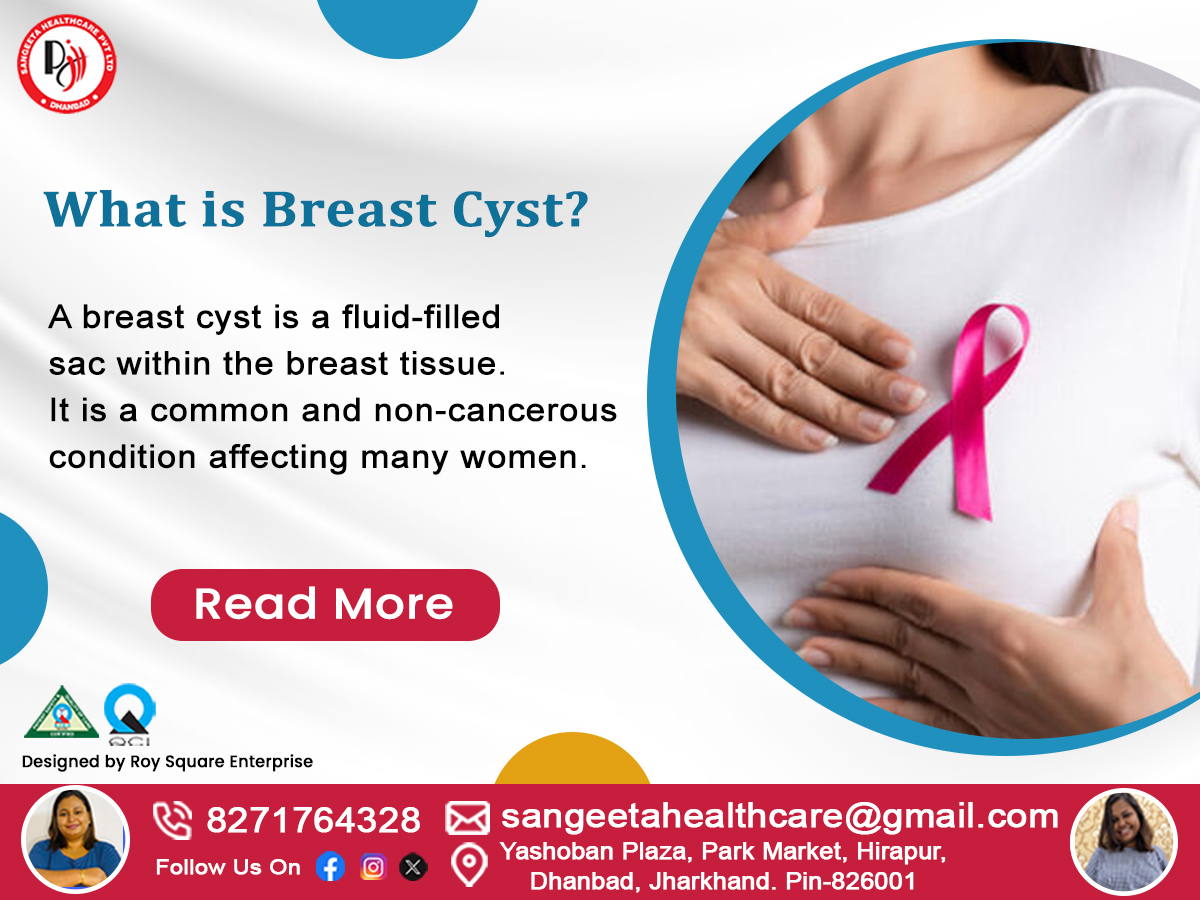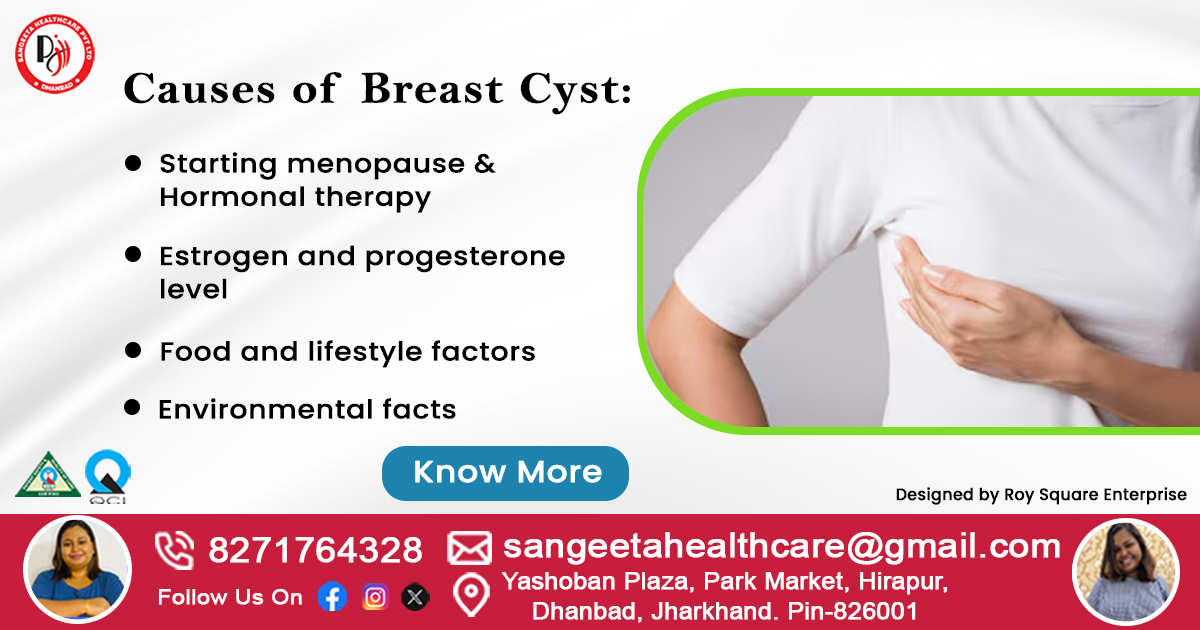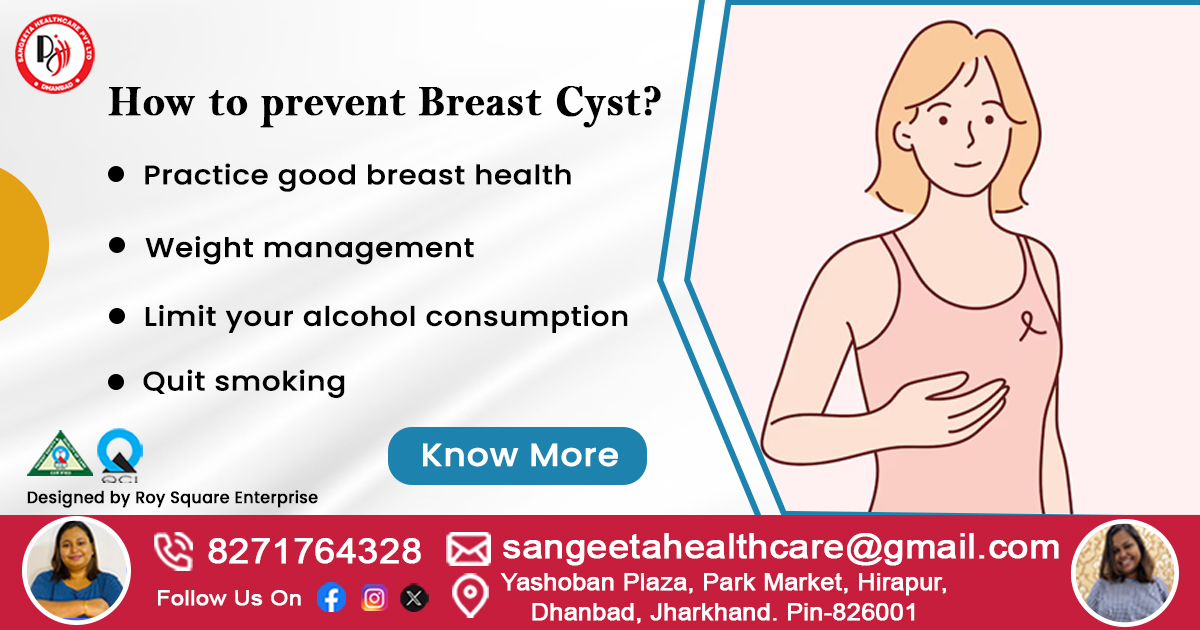Breast Cysts: Guide to Symptoms, Types, Diagnosis & Treatment

A breast cyst is a fluid-filled sac within the breast tissue. It is a common and non-cancerous condition affecting many women. Breast cysts can occur at any age, but mostly appear in their 40s and 50s. They can cause breast lumps, tenderness, discomfort and many others. You may have multiple breast cysts, some cysts are small and sometimes large enough. Early diagnosis and treatment can give you relief from symptoms.
What are the Symptoms of Breast Cysts?
Breast cysts can occur in one or both breasts. Many breast cysts don’t show any symptoms but you may find them during imaging tests. Still below mentioned visible symptoms indicate breast cyst:
- Lump or thickening
A lump or thickening in breast is the most common symptom of breast cyst. It looks round or oval in shape and smooth in different edges. Also, it may feel soft or firm to the touch.
- Pain or tenderness
Pain or tenderness is a sign of breast cyst. Especially just before menstruation, you may feel more pain in the affected breast because of cyst. The pain can be mild or sharp.
- Redness or swelling
Swelling or redness in the affected breast is common in breast cyst. The affected breast may look larger or swollen than the other one. You may notice warmth or tenderness in the skin over the affected area.
- Nipple discharge
Breast cysts cause nipple discharge. The discharge may be clear, cloudy or dark brown colour.
- Changes in size
The size of the lump can change. You may notice changes in your lump size before and after your menstruation.
Types of Breast Cyst
Your cyst can form in different formation. Types of breast cyst are:
- Simple Breast Cyst
Simple breast cysts are fluid-filled sacs that are non-threating and non-cancerous. They often resolve on their own, shrinking without treatment.
- Complex Breast Cyst
Complex breast cysts are fluid-filled sacs with thick walls, containing solid components in it. This kind of cyst contains both fluid and solid. Unlike simple cysts, complex cysts may require additional tests to understand if they are cancerous or not.
- Complicated Breast Cyst
A complicated breast cyst is a fluid-filled sac but it will have uneven borders or cloudy complicated cysts require closer examination to rule out any potential concerns.
Causes of Breast Cysts
Actually causes of breast cysts formation are unknown but the formation may depends on various points and those points include:

- Starting menopause & Hormonal therapy
Breast cysts are mostly happened with pre-menopausal women or with those who are undergoing hormone replacement therapy due to menopausal symptoms. Hormonal imbalance during periods are responsible for the increased prevalence. The imbalance of hormonal activity can have a impact on breast tissue, causing formation of cysts.
- Reproductive history
Women who have never given birth or who had their first child after the age of 30 may face a slightly increased risk of developing breast cysts.
- Estrogen and progesterone level
Changes in hormone levels during the menstrual cycle, pregnancy, and menopause can stimulate breast tissue growth, leading to cyst formation. Hormonal imbalances caused by certain medical conditions or medications, can also contribute to cyst development.
- Food and lifestyle factors
A diet high in saturated fats and low in fruits may increase the risk of breast cysts. Too much alcohol consumption disrupt hormonal balance and leads to cyst formation. Smoking introduces harmful substances that can disrupt hormonal balance and elevate the risk of breast cysts.
- Environmental facts
Prolonged exposure to certain environmental factors, including radiation and harmful chemicals, may increase risk of developing breast cysts.
- Family history
Women with a family history of breast cysts or breast cancer may be more likely to develop breast cysts.
Breast Cyst Diagnosis Procedure
Breast cysts are often detected during routine mammograms, but you may also detect larger cysts on your own. Procedures to diagnose breast cyst are:
- Physical Assessment: A physical examination will be conduct to locate the exact location of cyst and asses it’s consistency.
- Ultrasound : Through an ultrasound test doctor will check if the lump is solid or it is filled with fluid.
- Mammograms: Mammograms are commonly used to diagnose breast cysts. It provides valuable information about breast tissue and guide for further treatment process.
- Fine needle aspiration: In Fine Needle Aspiration process thin needle is used to extract fluid from the cyst which is then examined later. This helps to confirm the diagnosis of a breast cyst and it also rules out the possibility of cancer.
- Breast MRI: Your doctor will recommend to do the test only if they suspect cancer or if they want a clear detailing. MRI is the most sensitive test to detect cancer at early stage.
How to prevent Breast Cysts?
Few lifestyle changes can help you to prevent breast cysts. The points are:

- Practice good breast health: Breast exams and mammograms can detect changes in breast tissue. It can also detect the formation of cysts. Self examine is must, so that you can inform your doctor if you see changes.
- Weight management: Maintaining a healthy weight is very much important. Overweight or obesity is linked with breast cyst. Proper diet control is important and physical exercise also.
- Limit your alcohol consumption: As discussed before consuming alcohol daily can increase the changes of breast cyst. So, stop taking it or limit your consumption.
- Quit smoking: National Cancer Institute declares that smoking is linked breast diseases, including breast cysts. If you quit smoking your overall health will improve and it also reduce the risk of breast cysts.
Treatment of Breast Cysts
No treatment is required for simple breast cysts, sometimes they can resolve by their own. But for others cases treatment of breast cysts include:
- Fine needle aspiration can serve as both a diagnostic and therapeutic tool for breast cysts. If the procedure successfully drains all the fluid from the cyst, and your symptoms resolve.
- Birth control pills may help to reduce the chances of breast cysts by regulating menstrual cycles. However, due to significant side effects, hormone therapy, including birth control pills or medications like tamoxifen, is only recommended for women who have severe symptoms. Also, stopping hormone therapy after menopause may also prevent breast cysts from forming.
- Surgical removal of a breast cyst is not necessary for everyone. For exceptional cases surgery may be considered. Like breast cyst causing discomfort, a cyst contains blood-tinged fluid or other concerning signs.
FAQ: Frequently Asked Questions
- What is a breast cysts?
Answer: Breast cyst is a fluid-filled sac that forms within the breast tissue.
- Are breast cysts cancerous?
Answer: No, breast cysts are non-cancerous.
- What are symptoms of breast cysts?
Answer: Symptoms breast cysts may include a smooth, round lump, breast tenderness, and nipple discharge.
- How to prevent breast cysts?
Answer: While there is no exact way to prevent breast cysts but maintaining a healthy weight, eating a balanced diet, and avoiding alcohol or smoking may help reduce the risk.


